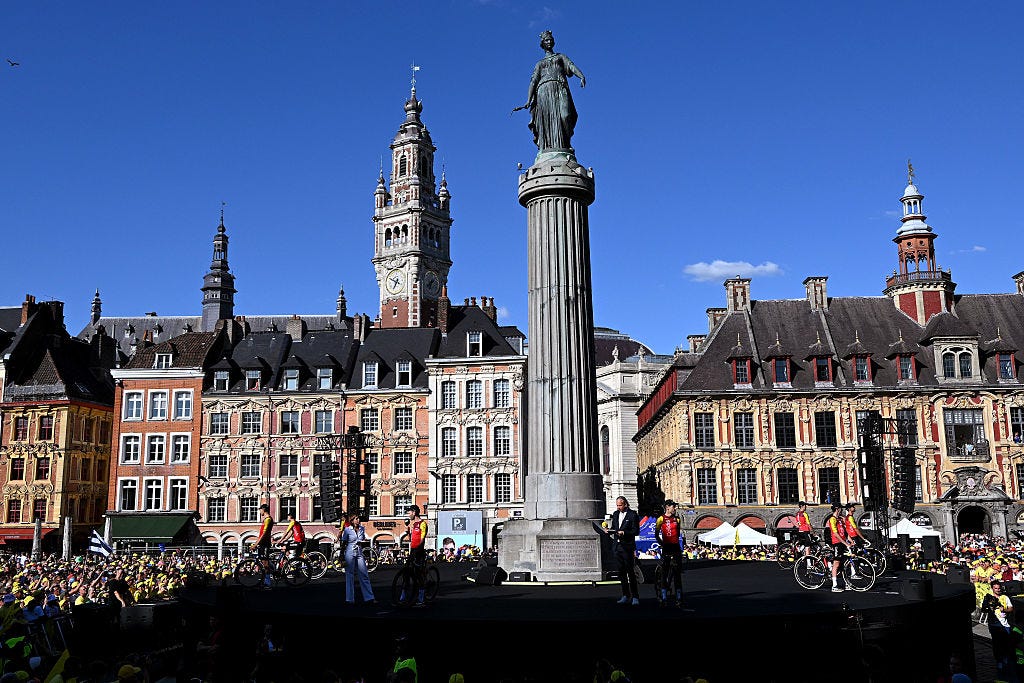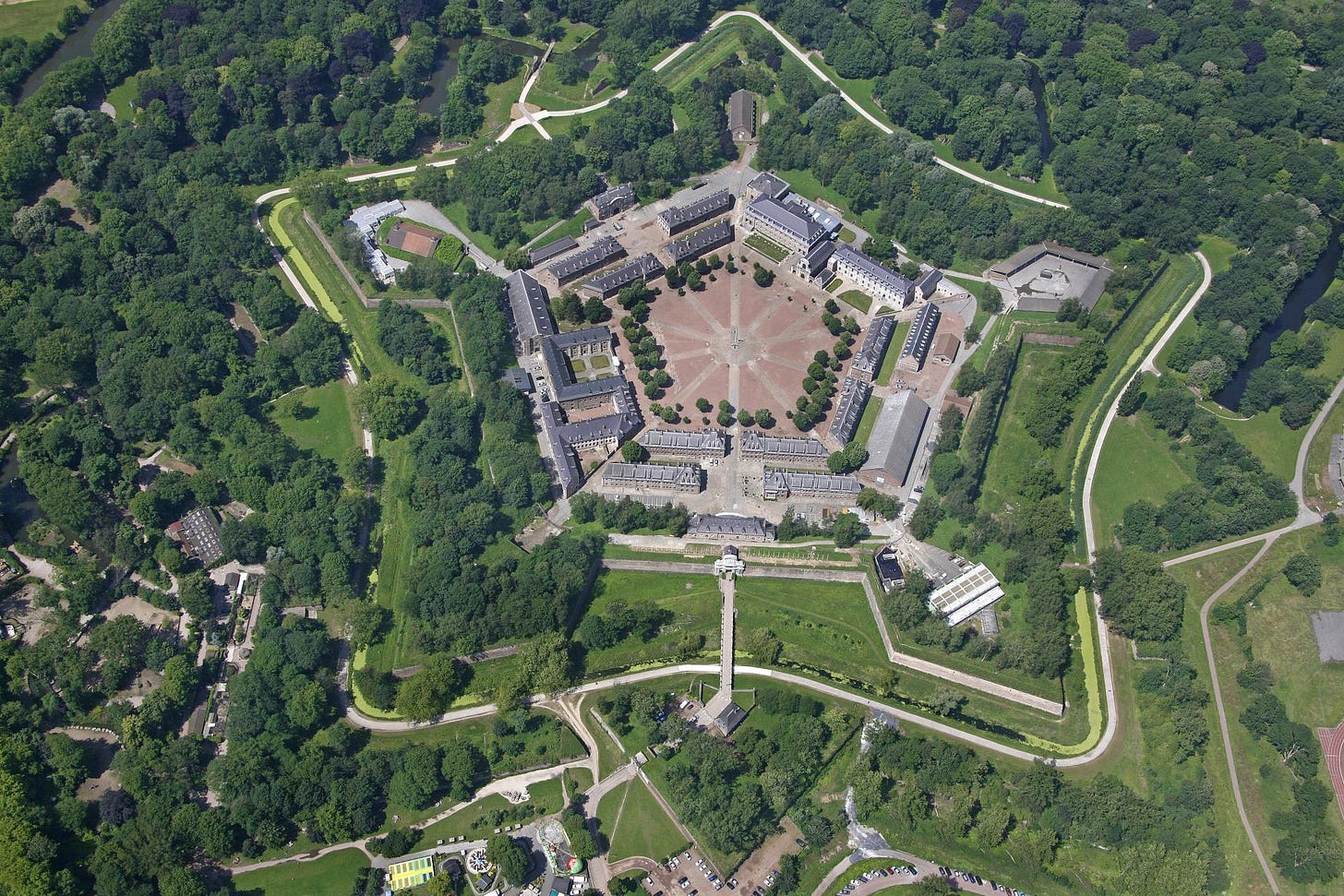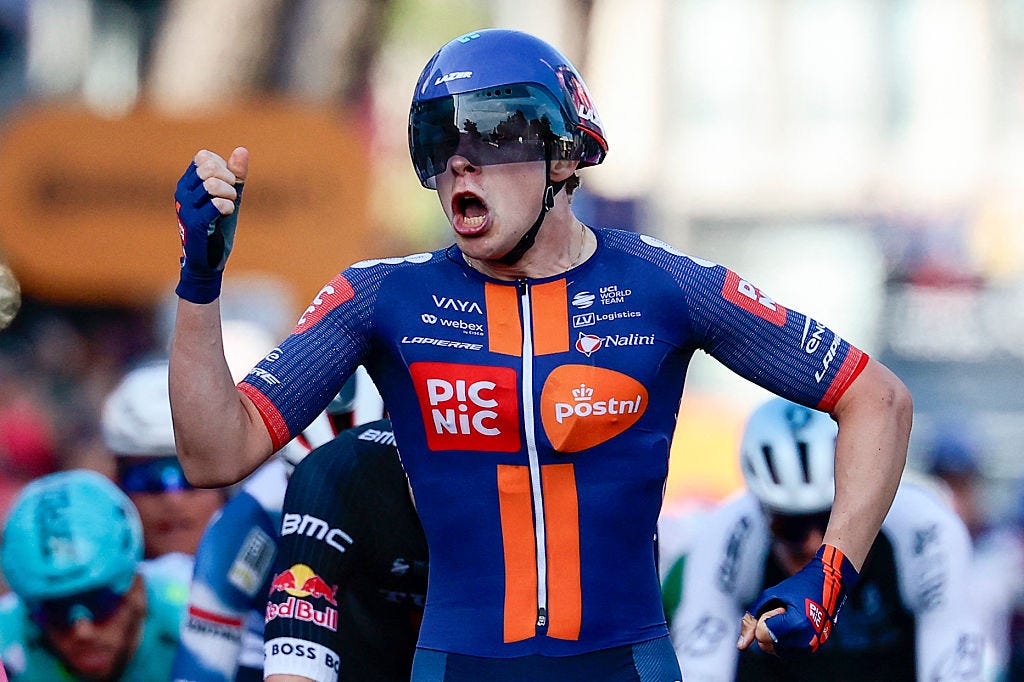Buongiorno! It is almost time for the start of the 2025 Tour de France. Can you feel the excitement? If you want to catch up on what happened last season in the Tour, you can see the latest and final installment of Netflix’s series Tour de France: Unchained, which is getting mixed reviews as usual. Fans of sassy Primož Roglič (Red Bull-Bora-Hansgrohe) should check out Episode 2!
If you’re ready to look toward this year’s race, the rest of this newsletter is for you! I’ll discuss this year’s Grand Départ, break down Stages 1 through 5, critique the UCI’s special anti-doping policy for the Tour, and finish with our look at emerging technology in the safety space. Andiamo!
The Grandest of Grand Départs
For the first time in a long time, the Tour will start in France and will stay in France the entire three weeks! I’ve discussed why Amaury Sport Organisation (ASO), the company that owns the Tour, is so high on starts outside of France: they raise the race’s profile and garner outsized fees from cities looking to host a Grand Départ. However, this year’s start at home in France is nothing to sniff at, especially since the year’s start city, Lille, is paying €4.2 million for the privilege.

Lille is a gem of a city, located in the far northern Hauts-de-France region of France. It is also the center of French Flanders, a region along the border with Belgium that includes Douai and Dunkirk. It’s an area that has alternately been part of the Holy Roman Empire, the Kingdom of France, the Dutch Republic, and the German Empire over the centuries, and has been fought over by the full panoply of modern European powers. And, with its proximity to Belgium and its crazed cycling fans, it is sure to be packed on Saturday for the first stage of the 2025 Tour.
For me, Lille sounds like a great place to visit. It’s been a European Cultural Capital since 2004, is directly accessible by train from Paris, and is THE place to eat the original girl dinner, moules frites. Yes, it has France’s worst air pollution, but otherwise Lille is at the top of my list of places to visit in France in 2026!
Stage Breakdowns!
Stage 1: 184.9km Flat Around Lille
We start off with one for the sprinters! This long loop around Lille, with a sojourn in Pas-de-Calais before returning to Flanders, should start out fast before hitting a small Category 4 climb at Côte de Notre-Dame-de-Lorette at 41.2km. Green jersey hopefuls will be gunning for the intermediate sprint points at Morbecque at 87.5km, while early polka dot jersey hopefuls will be looking to the two Category 4 climbs in the last half of the stage.

The last kilometer has a few turns before finishing on a straight flat below the Citadelle de Lille.
Stage 2: 209.1km of Hills from Lauwin-Planque to Boulogne-sur-Mer
Stage 2 starts in Lauwin-Planque, a tiny town in the Nord département, and a first-time Tour stage host! This is a perfect stage for a rider who wants to make a splash and grab the yellow jersey early in the race. Along the route west-northwest toward the finish on the Côte d'Opale in Boulogne-sur-Mer, there are a series of uncategorized punchy climbs, and two Category 3 and one Category 4 climb in the final 30kms.

Stage 2 finishes in the old town of Boulogne, right in front of La Basilique Notre-Dame and its 2,000-year-old crypt.
Stage 3: 178.3km Flat from Valenciennes to Dunkerque
Please don’t be offended, but every first week of the Tour has a flat stage that you should nap through. This year, Stage 3 is that stage. Both the start town of Valenciennes and the finish town of Dunkerque have hosted the Tour before, so there isn’t anything new there. The most we can hope for is some breakaway action and maybe some wind after the only climb, the Category 4 ascent of Mont Cassel at 147.4kms.
Stage 4: 174.2km of Hills from Amiens to Rouen
For Stage 4, the peloton will first transfer from the Nord département to Amiens in the Somme département. From there, the riders will travel southwest and then west to Rouen, in the Seine-Maritime département. We’ll get to the racing in a second, but I wanted to stop to mention the absolutely bonkers Rouen Cathedral, which I would very much like to visit.

This is basically equivalent to that house in your neighborhood that is always under construction and looks like it was renovated by half a dozen separate general contractors. Despite catching on fire four separate times, including once due to Allied bombers in the days before D-Day, Roen Cathedral is still a historic and architectural masterpiece. Although the peloton isn’t going by the cathedral, it will be visible to them as they tackle the two Category 3 and two Category 4 climbs after the sprint point at Saint-Adrien at 143.3kms. But they should be careful on the steep descent into the finish at Rouen!
Stage 5: 33km ITT in Caen
The last stage in this first installment is the Individual Time Trial in Caen. This stage could be an early test for our GC riders, who will be looking to prove their power on the flat roads of this time trial course, and an opportunity for green jersey combatants to pick up bonus points at the finish. The ITT is also a great opportunity for those of us watching at home to catch up on the latest ridiculous time trial helmets, like the Picnic Post-NL blob helmet from this year’s Giro:

And the seemingly Spaceballs-inspired Visma-LAB monstrosity:
For more in this vein, check out Wheely Sport’s excellent “All the Freaky World Tour Time Trial Helmets, Ranked by How Excited They Make Me About the Future.”
The UCI (Sort of) Puts Its Foot Down
After decades of doping scandals and constant speculation about doping in the modern peloton (some justified, some wildly irresponsible), the UCI is trying to get ahead of this year’s Tour by announcing enhanced anti-doping measures. The governing body’s plans cover two areas: rider testing, with the goal of analyzing and collecting more comprehensive, accurate, and long-term biological information, and mechanical testing, with the goal of preventing motor doping. For rider testing, the UCI will be increasing the number of tests and expanding testing beyond just the jersey-wearers and race leaders. They have already commenced a pre-race testing blitz and will be using advanced analytics to track blood and hormone levels from the pre-race period throughout the Tour. Some of this testing is meant to capture long-term trends, so it’s possible that doping could only be detected years later. This testing arms race, with teams getting more creative and pushing more boundaries and the UCI following along to keep everything in check, is what cycling fans have become used to. But the focus on motor-doping is something else entirely.
Here’s the issue: I’ve never believed that mechanical doping is actually happening. The UCI can x-ray every single bike in the race if they want, but I’m not convinced that teams are rolling out mechanical assistance techniques to cheat in Grand Tours. Yes, teams are constantly pushing the limits of gear technology to make everything lighter, faster, and more aero. But it goes against the entire ethos of professional cycling to resort to motors in races of this level. Just in case, the UCI is putting significant resources behind detecting motor doping, including instituting a bounty program for people who want to rat out their colleagues. If this is real and a team at this level is caught motor doping, I’ll admit that I’m wrong, but for now, I can’t see it actually happening.
Technology Corner!
Everyone knows cycling is dangerous. We’ve all seen the high speed crash footage played over and over again, and we’ve all mourned the loss of young riders in training and race accidents. The UCI is doing fuck all about it.1
That’s why it’s so great to see that academia is lending a hand. The Internet and Data Science Lab at Ghent University has created a prototype tracker for rider positioning, automated incident detection, and instant communication capabilities to enhance safety in the professional peloton. The tracker is being tested in training and race settings by riders on Team Soudal-QuickStep through a planned release in 2026. I think enhanced in-race communication is one of the ways to deal with the UCI’s inaction on safety issues. If the UCI isn’t going to design safer races, then riders, teams, and race officials should have more tools to respond to crashes as soon as they happen, and the data to show how future crashes could be avoided. This is why I’m also against one of the newest trends in armchair cycling, the growing calls to remove race radio and communications between the team cars and the riders. This can only make the riders less safe, and it would be a disastrous step backward for the sport.
Before I go, here are a few links for further reading if you’re too excited to sleep before the Grand Départ tomorrow:
If you want to brush up on all things cycling, Patrick Redford’s recent pieces at Defector have you covered!
If you’re interested in reading more about how the Tour is designed, check out this fascinating piece on the “mastermind behind the Tour”!
And if you want to feel bad about Primož Roglič one last time before I mercilessly rag on him for crashing in the first week of the Tour, here’s a nice piece on his expectations for this year’s race (and possibly his last Tour?).
Happy Grand Départ, and I’ll see you next Wednesday for our second installment!
I’m loath to give World Tour bigmouth Jonathan Vaughters (EF Education-Easypost) credit, but even a stopped clock is right that the UCI is a piece of shit.





Wheely Sport link doesn’t work and is un-google-able. I’m dying to read it just from the title alone!